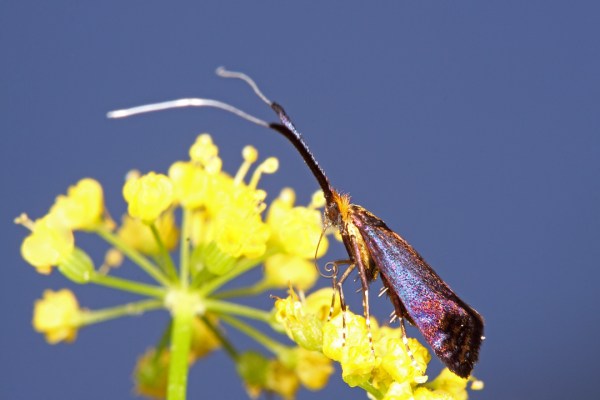
Adela caeruleella | Wayne Co., Missouri
Ever since I saw Chris Grinter’s beautiful photographs, I have wanted to see (and possibly photograph) the tiny little moths known as fairy moths (family Adelidae, formerly considered a subfamily of Incurvariidae). These dainty, delicate, little moths are characterized by their unusually long antennae—especially the males, which can have their antennae up to three times the length of the forewings. This past April I got my wish as my father and I hiked the Shut-ins Trail at Sam A. Baker State Park in Missouri’s southeastern Ozark Highlands.

Females have the antennae ”only” twice as long as the forewings…
Chris was fortunate to see a number of individuals representing at least two species, presumably all males (based on the extraordinary length of their antennae) that were engaged in some rather interesting territorial behaviors. I, on the other hand, saw only this single individual (presumably a female) who seemed content enough to calmly nectar the golden Alexander, Zizia aurea (Apiaceae), flowers on which I found it. This was fine by me, as the dense woodland setting where I saw it wasn’t very conducive to photographing the moth. I wanted a clean, bright background to highlight the moths dark metallic luster, so I snipped the flower (carefully!) on which the moth was nectaring and held it up to the small patch of bright blue sky visible from the trail to take these photos.

…and the basal half distinctly thickened.
I presume this individual represents the species Adela caerueleella based on comparison with online photos. According to Powell (1969) this species is widespread across the eastern U.S. and has been recorded on flowers of American bittersweet, Celastrus scandens (Celastraceae). Microleps.org notes the species is most frequently found along deciduous forest trails and shows a preference for flowers of black snakeroot, Sanicula marilandica (Apiaceae). My late April observation is consistent with the April and May activity period noted by Powell (1969) and late May period for central Illinois noted by Microleps.org.
REFERENCE:
Powell, J. A. 1969. A synopsis of Nearctic adelid moths, with descriptions of new species (Incurvariidae). Journal of the Lepidopterists’ Society 23:211–240.
Copyright © Ted C. MacRae 2012
Nice! I’m still waiting to see one of these in person. This spring I thought I had found some, but on closer inspection they were Mathildana newmanella (Oecophoridae), a moth with similar coloration to the one you found, but the antennae not quite so impressive.
I’ve seen that species, and it is a pretty little moth.
I won’t be truly happy though until I see a male Adela with those incredibly long antennae!
There are two species of ADELIDAE recorded from Missouri. Adela caeruleella is a resident species and Adela ridingsella whose status is unknown.
I just checked out the photos of A. ridingsella at Moth Photographers Group. A rather distinctive little species – I’m sure I’ll recognize it if I ever see it. Maybe southeastern Missouri would be the best chance of seeing it.
Beautiful shots yourself! It’s easy to see why there are so many Lepidopterists.
Thanks Jon. It was difficult to photograph in profile due to the length of the antennae – hard to get everything in the plane of focus. I think a dorsal shot with the antennae splayed out (like Chris’ photos) would have been better, but I still would’ve wanted the sky blue background.
Beautiful!
=) I, too, was very affected by Chris’s fairy moth post, and about TWO days later, for the 1st time EVER, SAW them. Completely NOT on purpose. I FREAKED. And I had a camera with me–que milagro! Mine are much like Chris’s (at biobabbler.blogspot.com/2010/04/freaking-out.html and from the next year, same kind, I assume, biobabbler.blogspot.com/2011/04/another-gift-fairy.html), but yours are so different! Amazing iridescence, and it’s very interesting how the antennae are fuzzy then not.
Great work finding and photographing them so beautifully. Thanks for sharing those amazing creatures! =)
Serendipity is a great thing!
BTW, linky #2 no worky – I had to do some searching but eventually found it: http://biobabbler.blogspot.com/2011/04/another-gift-fairy-moth.html 😀
Nice. Like Chris, I’ve only seen and photo’d the 2 common species here in CA – flammeuselle and trigrapha. But I’m always hoping for more… 🙂
Did you see any males? Photographs? I’m on a quest now!
Pretty sure I’ve seen males and females, but I think my flickr photos are both males:


I’d suggest the second one is a female – Chris Grinter has several individuals labeled as this species, one possessing distinctly shorter antennae and looking almost identical to yours; the others (surely males) with much longer antennae.
Oh, and your photos – jealous!
Thanks Ted. I had heard the red heads were maybe males, but see that’s not the case.
Wonderful photos Ted! And it’s wonderful to hear my photos have started a quest to find more of these, keep them coming!
And yes I agree the red-head shorter antennae moth is a female.
Hi Chris – thanks for confirming. Hopefully this April/May I’ll have some male photographs to share.